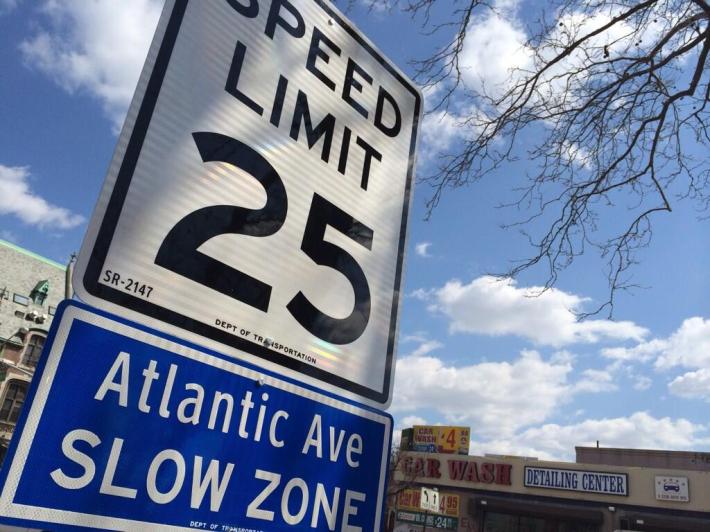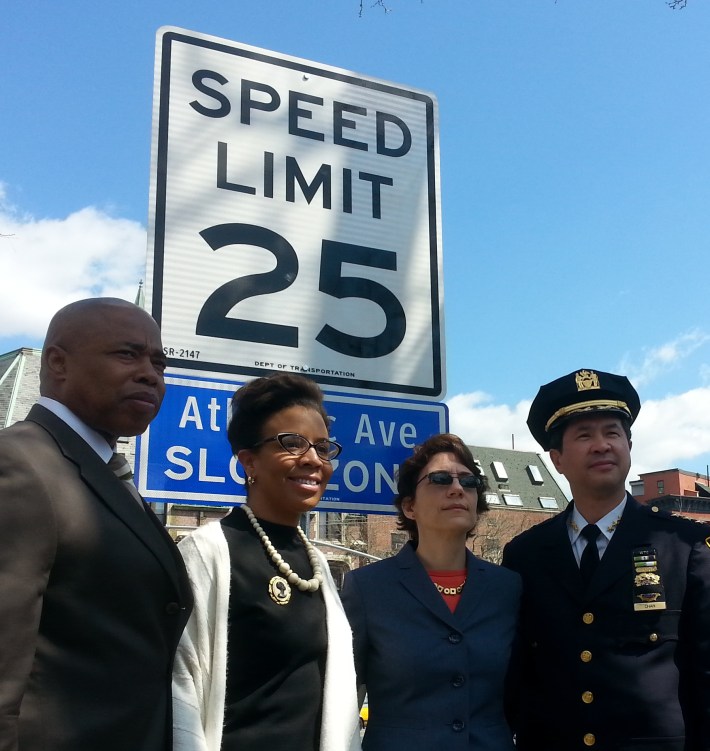Atlantic Ave First of 25 “Arterial Slow Zones” to Get 25 MPH Limit This Year
5:33 PM EDT on April 9, 2014
As drivers zoomed by on Atlantic Avenue this morning, local elected officials and advocates joined NYC DOT and NYPD to unveil the first of the city's "arterial slow zones," major streets where the speed limit will be dropped to 25 mph from the current citywide limit of 30 mph. Traffic signals will also be retimed to a 25 mph progression, to help keep motorists' speeds in check.

The arterial slow zone program, mentioned briefly in the city's Vision Zero action plan in February, will focus on some of the city's most dangerous streets. Arterials like Atlantic make up only 15 percent of New York's roadways but account for 60 percent of the city's pedestrian fatalities, according to DOT.
"New Yorkers are asking what we can do to fix these streets, so today we're taking immediate action," said Transportation Commissioner Polly Trottenberg.
"When we look at the family members who have lost loved ones, the pain never dissipates, and it never stops hurting," said Brooklyn Borough President Eric Adams. "We can have a smooth traffic flow of vehicles without having a reckless and senseless traffic flow of blood."
Streets chosen for this new program will receive new 25 mph speed limit signs, design fixes from DOT, and focused enforcement by NYPD, though the extent of the design and enforcement changes remained unclear at today's press conference.
First up: 7.6 miles of Atlantic Avenue in Brooklyn and Queens, from Furman Street in Brooklyn Heights to 76th Street in Woodhaven. (The project does not include the easternmost section of Atlantic as it approaches Jamaica.) From 2008 to 2012, there were 25 traffic fatalities along this section of Atlantic, including 10 pedestrian deaths. DOT said the new speed limit would go into effect by the end of April. By the end of the year, 25 major arterial streets will have lower speed limits and retimed traffic lights, the agency said.
Trottenberg said that these 25 "arterial slow zones" will count toward the 50 "intersections and corridors" the Vision Zero action plan promised would receive "safety engineering improvements" from DOT each year. "We're starting with the slow zones but we're also going to be doing some redesigning, too," she said.
DOT has already made engineering tweaks to some intersections along the avenue in recent years, including turn restrictions and curb extensions. "We're also going to look now at building out more of the medians to shorten crossing distances and improve safety," Trottenberg said. DOT staff didn't offer specifics about those changes this morning.
NYPD's Chief of Transportation Thomas Chan said the department would step up speed enforcement along Atlantic and other streets in the arterial slow zone program, and would also be issuing more tickets for failure to yield to pedestrians, disobeying stop lights and signs, improper turns, and illegal cell phone use.
NYPD's highway patrol issues the vast majority of speeding tickets in New York, with surface streets left to precincts. I asked Chan if he would be shifting highway patrol resources to arterial streets as part of the slow zone initiative. "The majority of the time they will be doing enforcement on the highways themselves," he said. "On occasion, we have deployed them onto local streets, but again, we are encouraging local precincts to do enforcement within their areas."
There are 10 precincts along the section of Atlantic selected for a slow zone. The 77th Precinct, which covers the area where today's announcement was held, has issued about two speeding tickets daily so far this year, according to the latest data available [PDF].
Speed cameras, which DOT has so far installed primarily along busy arterial streets, may also play a role in the program's enforcement component. Trottenberg would not say for sure whether cameras will be installed along Atlantic, but did say that DOT would look for areas on the avenue that fit within the tight limitations required by Albany. "There are a lot of areas that are high-crash areas where we can't use those cameras right now," she said. "We'd like to have local control over the number of speed cameras we deploy, and where and when we deploy them." The city is presently allowed to operate up to 20 cameras near schools during school hours. DOT has installed five cameras so far, which as of yesterday have issued 14,500 speeding tickets since they were turned on in mid-January.

The speed limit on residential streets near 25 mph arterial slow zones will remain at the citywide 30 mph default. The de Blasio administration would like Albany to lower the city's default limit to 25 mph, while street safety advocates are pushing for 20 mph, which could then be raised to 25 mph for exceptions like arterial streets. Trottenberg called 25 mph the "logical default" and said the city could go lower with 20 mph neighborhood slow zones. "At the moment we are pursuing 25," she said. "Our main goal is for New York City to wrest back control of its speed limits."
WABC's Dave Evans asked if the city has experienced any opposition from drivers who feel they need to drive 30 mph. "We haven't heard complaints from motorists that the speed limit needs to be higher," said DOT's Josh Benson, adding that the city wanted to educate drivers about the new limit. "It's not just, surprise, the speed limit's changed. We want to get the word out." Benson also said DOT was not concerned about drivers diverting to other routes, because local side streets are often not faster than arterials like Atlantic, even with the lower speed limit.
Chan and Trottenberg were joined by Families for Safe Streets founding member Amy Cohen, whose son Sammy was killed six months ago by a driver on Prospect Park West. In January, PPW received a 25 mph speed limit and traffic signal retiming. (DOT said today that it was not counting that street as part of its arterial slow zone program.)
"Today's announcement is a positive step; however, it is only a first step," Cohen said. "I have come here today to remind everyone of the urgency of this work."
Council Member Laurie Cumbo cheered today's announcement. "We are going to have an answer for these families. We are going to show that the city is moving in the right direction," she said, mentioning a call she and advocates made late last month for DOT to take action along Atlantic. "To have this roll out less than a month [later] is impressive, and it shows that our voices as a community have been heard."
Cumbo said she wants to focus next on Eastern Parkway, especially near Schenectady and Utica Avenues. Whether that will lead to a pedestrian-friendly solution remains to be seen. Cumbo said she is assisting 77th Precinct Deputy Inspector Eddie Lott, who suggested that the city install pedestrian fences near the Utica Avenue subway station to keep people from crossing Eastern Parkway when they aren't at an intersection. "People [are] coming out of the train station at Utica, and just running across the street in the middle of the street," Cumbo said. "We've got to see some change there."
Trottenberg didn't name the 24 other streets included in the arterial slow zone program, but said it will include all five boroughs and the choices shouldn't surprise New Yorkers. "A lot of the big roads that you've been hearing about, I think you know they will be part of future announcements," she said. "You'll have to stay tuned."
Stay in touch
Sign up for our free newsletter
More from Streetsblog New York City
Adams Offers Bare Minimum to Seize Congestion Pricing’s ‘Space Dividend’ Opportunity
The mayor's list of projects supposedly meant to harness congestion pricing's expected reduction in traffic is mostly old news, according to critics.
OPINION: Congestion Pricing Will Help My Family Get Around As We Navigate Cancer Treatment
My partner was recently diagnosed with cancer. Congestion pricing will make getting her to treatment faster and easier.
EXCLUSIVE: OMNY Debuts on Fair Fares After Delays
The long-awaited Fair Fares expansion will launch as a three-month pilot for a few dozen riders.




